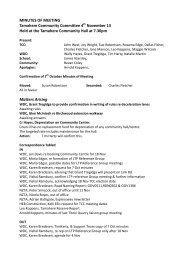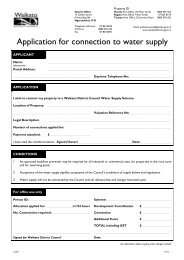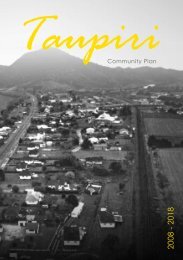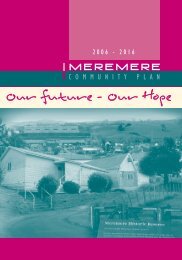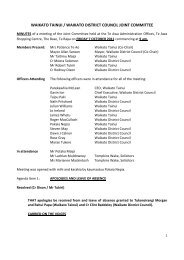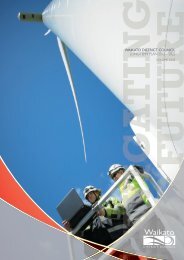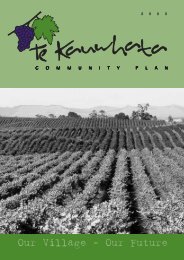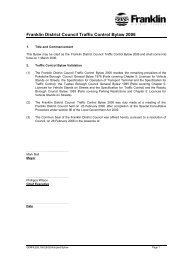“…material that when discharged to the environment will have no adverse effect on people or the environment. Thisincludes natural materials such as clay, soil and rock, and other inert materials such as broken concrete and brick, ormixtures <strong>of</strong> any <strong>of</strong> the above, and excludes:(a) material that has combustible, putrescible or degradable components, and(b) materials likely to create leachate by biological or chemical breakdown, and(c) products or materials derived from hazardous <strong>waste</strong> treatment, hazardous <strong>waste</strong> stabilisation or hazardous<strong>waste</strong> disposal practices, and(d) materials such as medical and veterinary <strong>waste</strong>, asbestos, or radioactive substances that may present a risk tohuman health, and(e) materials contaminated with hazardous substances or pathogens, and(f) hazardous substances.This definition is very similar to, but not exactly the same as, the Cleanfill Guidelines definition quoted above(for example liquid <strong>waste</strong> is not mentioned).For some types <strong>of</strong> <strong>waste</strong>, cleanfills are competing directly with landfills. However, cleanfills are much less costlythan landfills to establish and require much lower levels <strong>of</strong> engineering investment to prevent discharges intothe environment. Cleanfills also have much lower compliance costs than landfills. Because <strong>of</strong> these differingcost structures, cleanfills charge markedly less for disposal than landfills, <strong>of</strong>ten on the order <strong>of</strong> 10 per cent <strong>of</strong>landfills’ gate charges.There are several consented cleanfill operations in the <strong>Waikato</strong> district.Table 2: Cleanfill facilitiesName/operatorBombayQuarry,HolcimKey services/<strong>waste</strong> streams Location Capacity & estimatedoperational lifeCleanfill disposal, for quarry customers onlyRidge Road,BombayUp to 500,000 m3 from late2011, consented to 2025PerryResourcesLtdCleanfill disposal for public (topsoil, clay,spoil); $5 plus GST per tonne, if takingsand $4.50 plus GST, topsoil is free (laterscreened and sold)HutchinsonRd, HorotiuConsented to 2030Wedding IH& Sons LtdCleanfill, construction and demolition<strong>waste</strong>, sand, subsoil, clay and compostBedfordRoad, TeKowhaiUp to 109,500 m3 per annum<strong>of</strong> cleanfill and C&D <strong>waste</strong>Te KowhaiSandsCleanfill (preferably topsoil forrehabilitation)SH39, TeKowhaiConsented till 2021, but willlikely be at capacity by end <strong>of</strong>2011Envir<strong>of</strong>ertCleanfill (clay, soil, rock, concrete, brick,demolition products)(Take other materials such as plasterboardbut these are reprocessed)GeraghtysRoad,TuakauCurrently consented to 2019,but intend to extend consentsS D WatsonLtdCleanfill (concrete, clay and topsoil) forland contouringBucklandRd, Tuakau35,000 m3 per dayWhangarataQuarry,Ridge RoadQuarry LtdCleanfill and quarryRidge Road,BombayUp to 700,000 m314
Name/operatorRX PlasticsLtdCharbertHoldings LtdEnviroLandfill(Pukemiromine)Ridge RoadQuarry Ltd(WhangarataQuarry)Key services/<strong>waste</strong> streams Location Capacity & estimatedoperational lifeCleanfill (only clay, sand for siteremediation)CleanfillCoal mine, cleanfill, end <strong>of</strong> life tyres,construction and demolition <strong>waste</strong>CleanfillHorotiuRoad,HorotiuBucklandRoad,PukekoheHangapipiRoad,Huntly/PukemiroRidge Road,Bombay78,800 capacity, consentedto 2022. Nearly to capacityand only accepting good basematerialUp to 12,000 m3 per annum130,000 m3 per annum700,000 m3 capacity.consented to 2019There are a number <strong>of</strong> other current cleanfill consents, but these are generally secondary to another activity(e.g. civil construction projects, housing or other <strong>waste</strong> management operations) and have not been includedhere as they are short term and/or do not accept <strong>waste</strong> from external sources.Two <strong>of</strong> the cleanfill facilities, Enviro Landfill and Wedding, have specific consents to dispose <strong>of</strong> construction anddemolition <strong>waste</strong>, with the Enviro Landfill also having permission to dispose <strong>of</strong> ‘end <strong>of</strong> life’ tyres. Some <strong>of</strong> thesematerials arguably do not fit the regional or district council definitions <strong>of</strong> cleanfill given above; however theregional council has awarded consents enabling these facilities to dispose <strong>of</strong> these materials.2.1.4 Assessment <strong>of</strong> residual <strong>waste</strong> disposal infrastructureThe most significant facilities in the area are the Hampton Downs landfill, and the various cleanfill facilitiesaround the district. A review <strong>of</strong> these facilities suggests that there is sufficient capacity to accommodateresidual and cleanfill <strong>waste</strong> streams over the next 20-30 years. However there are some potential issues fromoperational and management perspectives.Any potential negative environmental effects <strong>of</strong> the Hampton Downs landfill are strictly controlled throughtheir resource consents and monitoring. However the operators are not required to provide any informationto district or regional councils regarding the tonnage, composition, or source <strong>of</strong> the <strong>waste</strong> they accept. Underthe landfill levy scheme, they do have to report to MfE on the total amount <strong>of</strong> <strong>waste</strong> disposed <strong>of</strong> per annum;however MfE only releases aggregated data.Cleanfills over a certain size are able to be identified as they require resource consents to operate. Facilitiesunder <strong>this</strong> size (2,500 m3 per annum) are permitted activities and as such are not readily identifiable. Basedon the definition <strong>of</strong> cleanfill given by both MfE and the council, it is questionable whether cleanfills are anappropriate method <strong>of</strong> disposal for some construction and demolition materials, and for tyres. For example,the MfE website states ”the disposal and storage <strong>of</strong> old and unwanted (end-<strong>of</strong>-life) tyres has a number <strong>of</strong>potential adverse environmental and health impacts”.The regional council records at the time these consent decisions were made suggest that a future ‘end-<strong>of</strong>-lifetyre’ stewardship programme would soon be in place, implying that disposal was seen a stop-gap measure.The operators <strong>of</strong> the Enviro Landfill site also had inherited a significant historic stockpile <strong>of</strong> <strong>this</strong> material whichrequired a solution. Identifying alternative management options for construction and demolition <strong>waste</strong>, andend-<strong>of</strong>-life tyres, is an issue for the district.<strong>Waikato</strong> <strong>District</strong> <strong>Council</strong> <strong>waste</strong> <strong>assessment</strong> 201115



